
4 Nights up North – Things to do in Tyne and Wear
In the current situation, travel options are a tad limited. So, when thinking about destinations for our late summer holiday, it was clear that it would be within the UK. No way would I risk having to quarantine for a fortnight. It was just the question of where to go. One favourite was Cornwall, as we originally planned to go there in July, then had to cancel for family reasons. Alternatively, maybe another trip to the Isle of Wight? After all, it’s been a year and a half again, since we last went (and as some of you might remember, thanks to me getting stuck in Paris, that weekend was a little shorter than planned). But in the end, we decided to head up north and stay in Sunderland for four nights. We’ve never actually been there, but for sure there’d be plenty of things to do in Tyne and Wear?
OK, before I tell you about our itinerary and all the things to do in Tyne and Wear, let’s get the obvious question out of the way.
Why stay in Sunderland?
The truth? Because it was available and affordable. Buying a house and being on furlough for a while, didn’t really leave us with a huge travel budget this summer. (also, let’s not forget, we have had our big holiday for the year already back in March with a week in New York).
Therefore, the idea of heading to Cornwall quickly died when the places we liked started at £200 / night. No way would I spend that kind of money for a few days away.
We knew we wanted to be somewhere by the sea, and we wanted to take the bikes. So, access to some decent cycle routes and nice scenery would be an added bonus. We’ve been to Norfolk before (Mr T even cycled all the way up there last year), so initially we searched in that area again. Then decided to look a bit further up the coast, towards the National Park and Whitby. And eventually settled for Sunderland. Maybe not the prettiest of towns, but it fit the bill. A base for our daily excursions, access to cycle paths and near the sea. And all of that without the hefty price tag of the more scenic locations like Tynemouth and Whitley Bay.
Where is Tyne and Wear?
Before we finally dive into all the things you could do in Tyne and Wear (and a lengthy report of our time up there), how about we cover the basics?
Tyne and Wear is a region in the North East of England. It includes the cities Newcastle upon Tyne and Sunderland and is flanked by County Durham and Northumberland. It takes its name from the two rivers Tyne and Wear that run through it.
What to do in Tyne and Wear – Our Itinerary
Anyone that’s been following my blog for a while knows, that I am most likely to just wing it whenever I go somewhere. Actual preparation isn’t really my strength. But for once we managed to check beforehand what there is to see and do in Tyne and Wear and put together a little itinerary. Not only was I curious to find out what there is to do around Sunderland. But I also wanted to check, if places had re-opened, if I needed to book any tickets upfront and what we needed to take into consideration before visiting. In the current climate, visiting places takes a little more preparation than it used to.
Turned out that a few of the places were still shut but we should find enough things to do in Tyne and Wear to keep us occupied for the time we’d be there.
So, here we go, our very rough itinerary of what we were planning to do in Tyne and Wear:
Day One:
Drive up to Sunderland
Roker Pier and Beach
Day Two:
Tynemouth and Whitley Bay – possibly as a cycle tour
Day Three:
Newcastle upon Tyne
Angel of the North
Day Four:
Penshaw Monument
Beamish, the Living Museum of the North – possibly as a cycle tour
Day Five:
Hadrian’s Wall
Drive back home
Four Nights up North – Day One
We estimated a 4 ? to 5 hour drive up to Sunderland. No need to get up crazy early for once. Since we knew we couldn’t check into our Airbnb until the late afternoon, we decided to take a little detour on the way. When setting out, we hadn’t yet made up our mind whether that would mean a stop-over in York, or Middlesbrough. Or a drive through the North York Moors National Park to either Scarborough or Whitby.
In the end we settled for Whitby. Although, in hindsight, what looked like a short detour, ended up being a good two hours extra. Since the drive involved a lot of smaller country roads (and heaps of traffic).
We loved the very scenic drive through the National Park. I must say, I wouldn’t mind coming back and spending some more time there. But for now, we only had a quick stopover to snap a few photos.
Arriving in Whitby we decided to park up on the cliff. The plan was to walk down to the harbour and pier, cross the bridge and walk up to the abbey. However, once we got down to Pier Road, this turned out to be a really bad idea. As Whitby was absolutely packed with people. Distancing was sheer impossible. So, once we had grabbed some lunch to take away, we headed back to the beach. No way would I spend my day wedged in between strangers climbing up the stairs to the abbey.

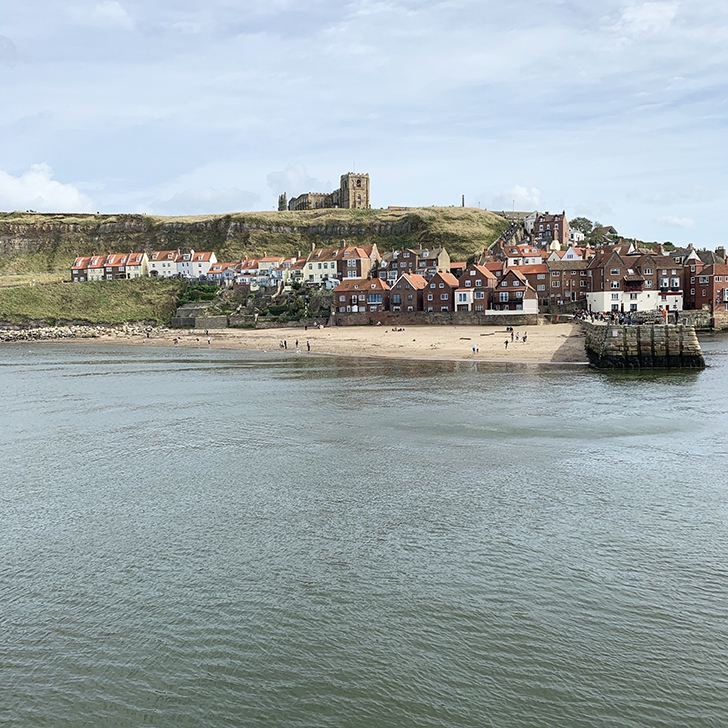
Once checked into the Airbnb and with the car unloaded, we decided to make the most of the afternoon and started exploring. Having spent most of the day sitting in the car, we opted for a walk. Through the town centre of Sunderland, across Wearmouth Bridge and towards Roker Pier and Beach.
Relying on Google Maps, the route wasn’t the most scenic (as it went for shortest route down the main road rather than the slightly longer one along the water). But Roker Beach turned out to be rather pretty. Most of the little restaurants and cafes were already shut for the day. But since we weren’t really after food, it didn’t matter. We walked the entire length of the pier to the light house and back, then eventually back towards our Airbnb to call it a day.
Trip up North – Day Two
Destinations for Day Two were Tynemouth and Whitley Bay. I mean surely you can’t miss those two gorgeous coastal towns of your list of things to do in Tyne and Wear. And since we brought the bikes with us, we decided to make the most of the glorious weather and cycle there. The good news is that we could just follow Cycle Route 1 all the way. The bad news (for me) was the overall distance. The entire route would be 46km, which is the furthest cycle ride I’ve done in the last two decades (or more).

As we were cycling along the coast, in my mind this meant a relatively flat ride. Turned out it wasn’t quite that. The route still had its ups and downs. Plus, we would need to take a ferry to actually cross the River Wear (unless we fancied a rather lengthy detour via Newcastle, which I most certainly didn’t).
On weekends, Shield Ferry runs every 30 minutes with the first one that day at 10.15 am. The first stint to get to the ferry in South Shields was about 10 miles (16km) and should have taken us more or less an hour. OK, seems I was a little slow. Since it was closer to 1.5 hours, by the time we eventually got to the ferry. Resulting in us actually running down the pier to catch it.
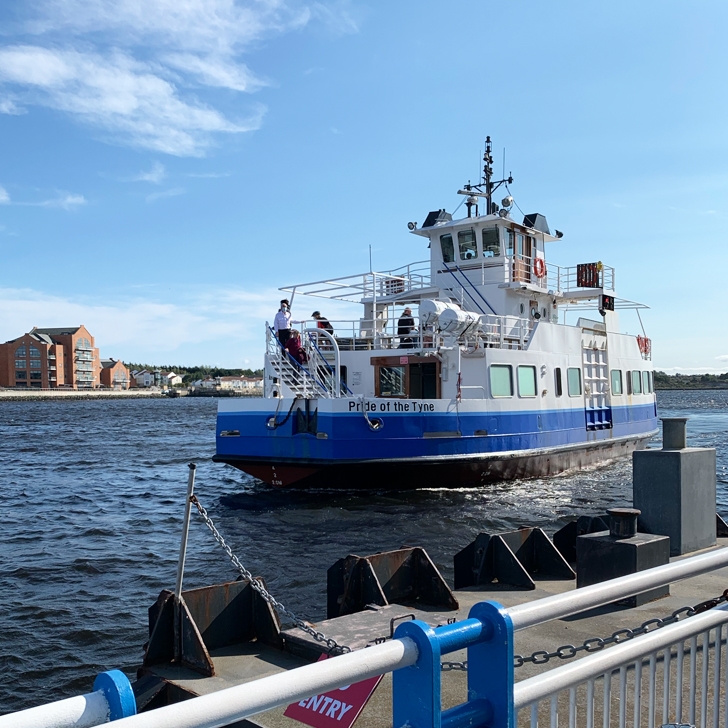
Shield Ferry costs £3/day for adults (or £1.80 one way) and there is no need to buy tickets upfront. You can just buy them as you board the ferry (and yes, they do take card, so don’t worry about bringing cash). And you can bring your bicycle free of charge (well, at the moment they only allow a maximum of 6 cycles on the ferry, but since it was already end of season, that wasn’t a problem).
The ferry ride is less than 10 minutes, so just enough to catch my breath and have a swig of water before it was time to get back on the bikes.
From North Shields we continued our ride to Tynemouth. Which was only another 2 miles (3km), but somehow all uphill.
With the bikes parked and secured, it was time to explore Tynemouth.
With almost 70.000 inhabitants, Tynemouth is by no means a small coastal town. But it feels rather villagey as you walk its streets.

We decided to not visit Tynemouth Castle and Abbey (it was open for visitors, but you had to pre-book tickets) and instead walked down Front Street.
After all that cycling, a quick coffee and cake break at one of the local cafes sounded much more appealing. I must say, what I liked about Tynemouth (and particularly Front Street) were all the small independent shops and cafes. Not your usual mix of high street brands.
We continued our stroll through the town towards Tynemouth Station. After all, the reason for me wanting to visit Tynemouth on the Sunday was the market, that is open only on weekends. When putting our itinerary of things to do in Tyne and Wear together, I came across the market in the station. However, I certainly didn’t expect it to be quite as picturesque. The Tynemouth Metro Station is a Grade II listed building. Originally opened in the late 19th Century, it was renovated a couple of years ago.
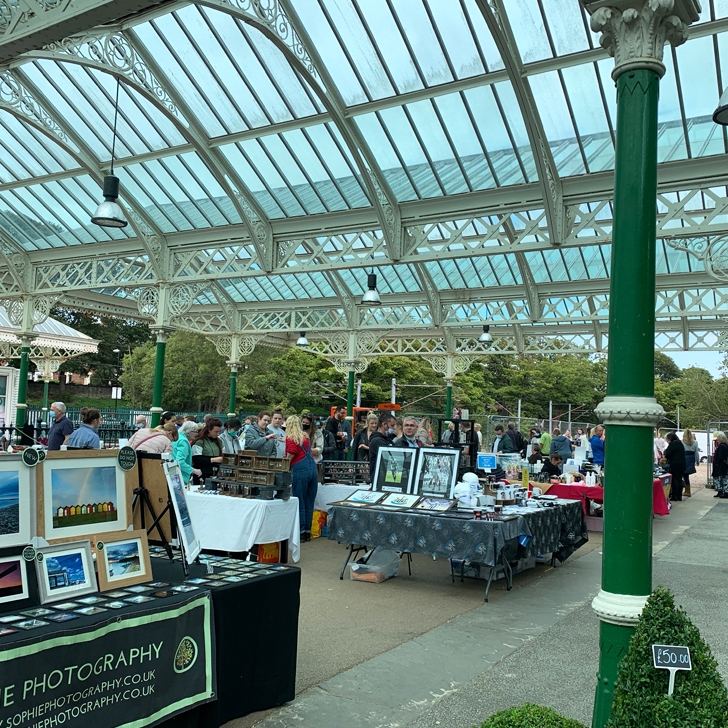
The weekly market is open Saturdays and Sundays from 9 till 3.30 and it is a mix of farmer’s market, flee-market and antiques fair. I absolutely love rummaging through this kind of market. And was rather tempted with a couple of pieces (although Mr T didn’t quite buy into the idea of transporting a massive Hovis advertising board back on the bikes).
With our market rummaging over, we headed back towards the beach and eventually back to the bikes. After all, we weren’t quite done with our cycle tour yet. On to Whitley Bay. Which was another 3 miles (5km) along the coastal path (also known as National Cycle Network Route 1).
Just before we left the beach, we did come past an old sea bath. Long closed and fallen into disrepair (and filled up with rubble and concrete, making it look rather unsightly), there is a community driven regeneration project on the way to revive and reopen the outdoor pool. I mean how fab is that?
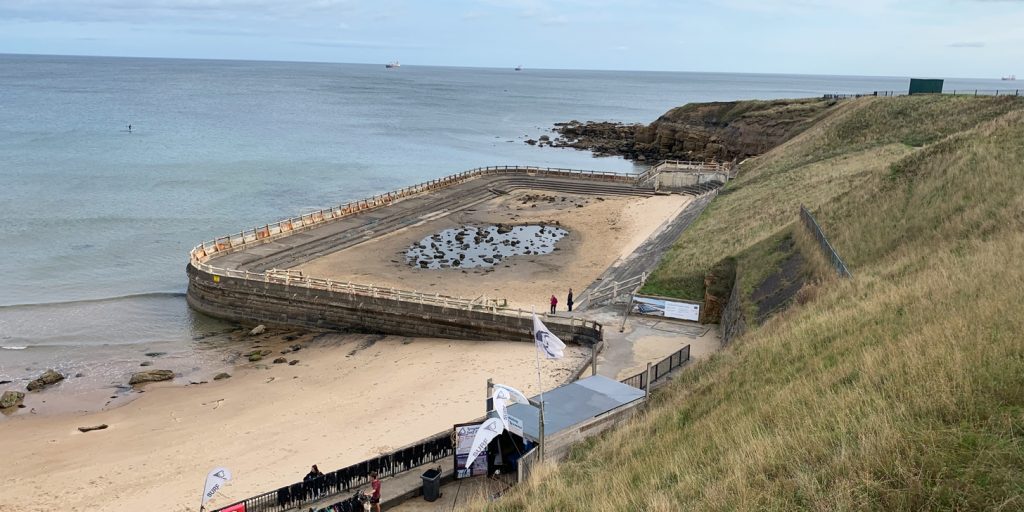
Whitley Bay is another seaside town that obviously needed to go on our ‘What to do in Tyne and Wear’ list. After all, being near the seaside was one of the main points when determining our holiday destination. With around 36. 000 inhabitants, Whitley Bay is smaller than Tynemouth. But it felt a lot busier. First thing we saw as we parked up the bikes was the Spanish City. A massive white building with a dome. Not quite what you’d expect in the North of England. But one that certainly wouldn’t look out of place in some of the other English seaside towns like Eastbourne or Brighton. Originally opened in 1910, the Spanish City was recently refurbished and re-opened, now housing several restaurants and a hotel.
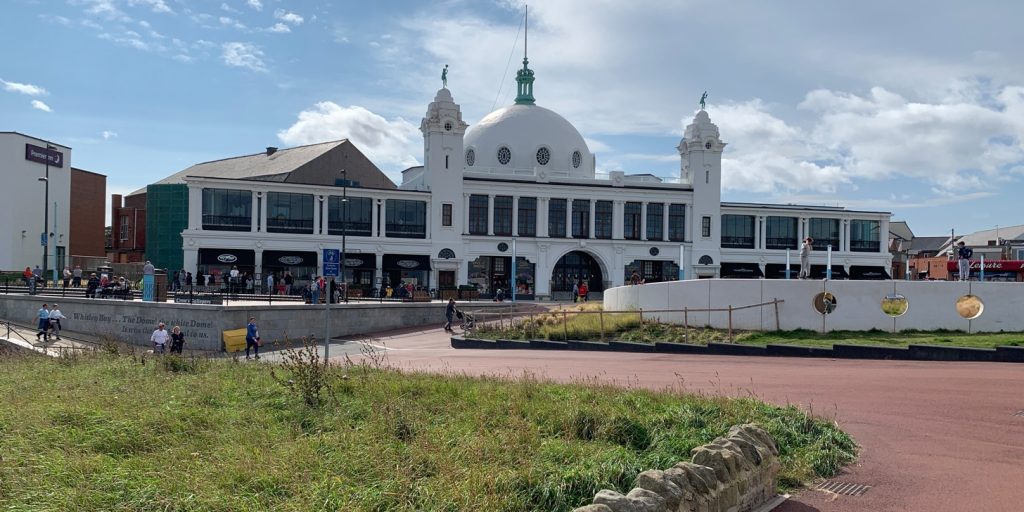
Since it was a super sunny Sunday, the beach and promenade was fairly busy. So were the fish & chip shops. Because obviously, we had to have fish & chips by the beach. I mean, it would be rude not to.

Once we had enough of the beach and the seaside, we decided to head back towards Sunderland (after all, I still needed to cycle back before I lost all steam). For convenience (and as it was the shortest route) we went the same way back that we came.
Day Three up North
Obviously, we couldn’t miss Newcastle upon Tyne from our itinerary of things to do in Tyne and Wear. So, on Monday, we decided to take the Metro into Newcastle for a day trip. Turns out, the Metro connections are actually quite handy up in Sunderland and Newcastle. At just £5.30 for the day ticket for all zones, the tickets were a bargain. And it was less than 30 minutes to actually get to Newcastle Central. Yes, it meant having to wear a mask for the entire journey (not something Mr T is too keen on, since he has trouble breathing through the mask). But certainly, less stressful than driving into town and probably cheaper than parking in Newcastle all day.
But taking the Metro obviously meant, we wouldn’t be heading to the Angel of the North that day. Not to worry, we still had some time, so we’d just add that to another day. What are we, if not flexible?

Talking of being flexible, we hadn’t really planned a full itinerary of what to do and see in Newcastle for the day. Chances were, we would do our usual, just walk along, see what’s there and enjoy the day.
The only venue I did get tickets for was the Baltic Centre for Contemporary Art. OK, the BALTIC isn’t really in Newcastle, it is in Gateshead, which is the other side of the River Tyne. But since Gateshead and Newcastle are directly linked by seven bridges, it doesn’t really feel like two different cities. And truth to be told, it was only now, that I looked it up again to write this post, that I found out that Gateshead is actually a town of its own. To me, this was just an area of Newcastle… whoops, guess that tells you something about my knowledge of England’s North.
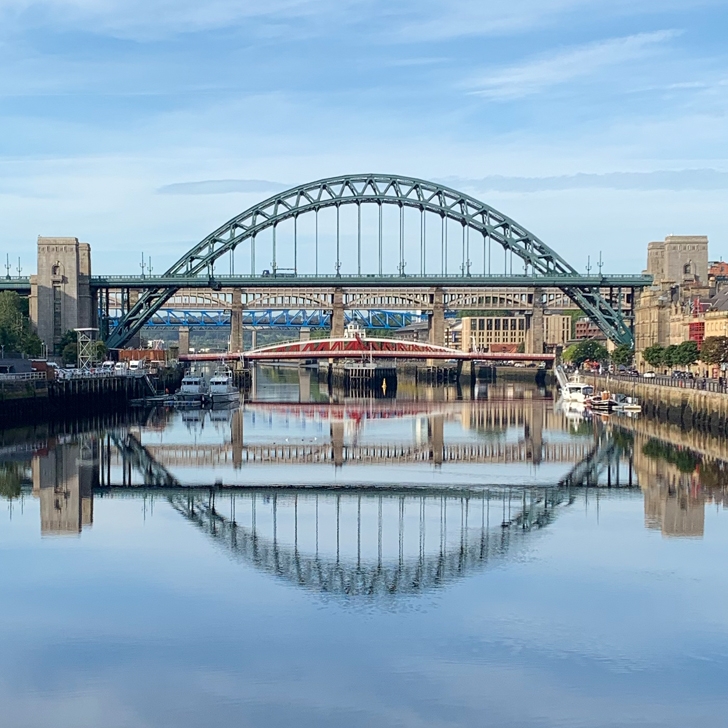
Another thing I did actually want to see, but left too late to book tickets (yes, I know, that’s a first for me, will I ever learn?) was the Victorian Tunnels. But even though they had recently reopened, they were running very limited tours and therefore sold out quick.
Since we started the day early and the Baltic Centre wouldn’t open until 10.30, we spent our wait time by the River Tyne, looking at the various bridges and having a coffee (or two).
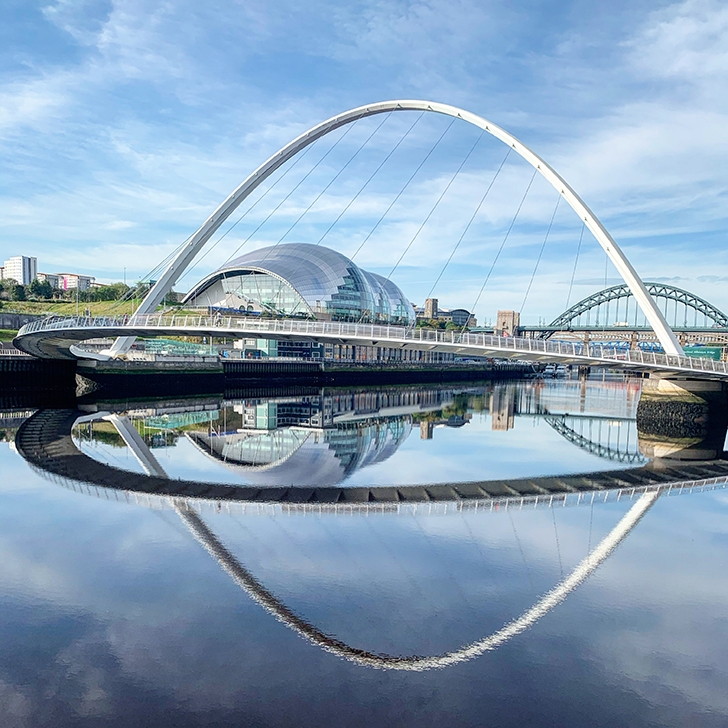
As we sat there, we couldn’t fail to notice the Sage, next door to the Baltic Centre. A huge steel and glass structure, it is actually a concert hall, designed by Foster and Partners and opened in 2004. Unfortunately, I didn’t get a chance to look inside.
The Baltic Centre is a contemporary art museum, that opened in 2002. It does not hold a permanent collection, only individual exhibitions and is housed in a converted flour mill. The impressive brick building dates back to 1950 (although the design was actually one of the 1930s) but closed as a mill in the early 80s.
The BALTIC has several viewing platforms, giving you are great view over the River Tyne, its bridges and Newcastle upon Tyne.
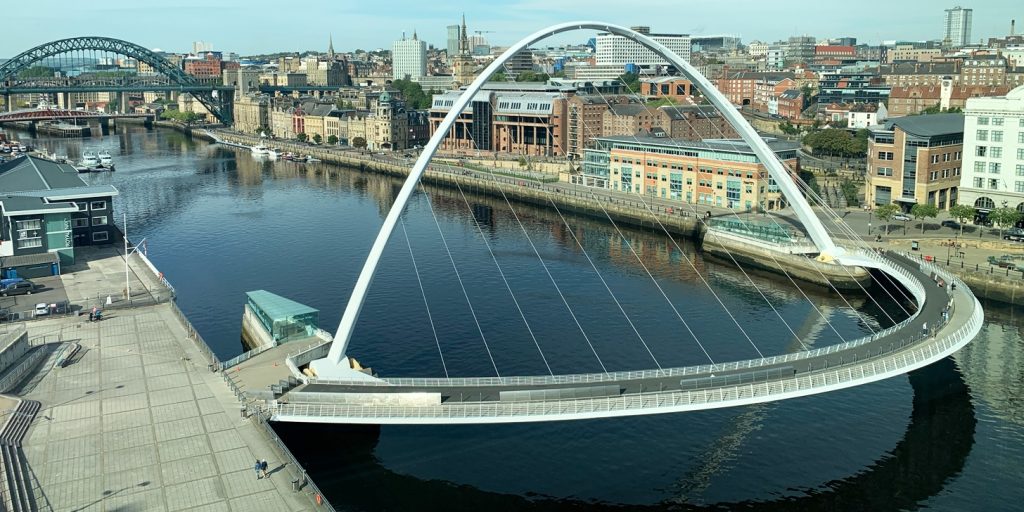
Unfortunately, not all areas of the centre had re-opened yet (and the two exhibitions they had on at the time weren’t quite to our taste). So, we ended up spending just 15 minutes in there, mainly looking out over Newcastle.
By the way, the Baltic Centre is free of charge. But you will have to pre-book a free ticket with a dedicated entry time via their website.
OK, with the Baltic Centre ticked of our list of things to do in Tyne and Wear, it was finally time to explore Newcastle itself.
Back via the Gateshead Millennium Bridge, a tilt bridge, accessible for pedestrians and cyclists. The impressive curved steel bridge was designed by WilkinsonEyre and opened to the public in 2001 (so it didn’t quite make it for the millennial year). But Newcastle was very proud of the fact that their millennium bridge did not wobble, unlike the London one in the beginning.
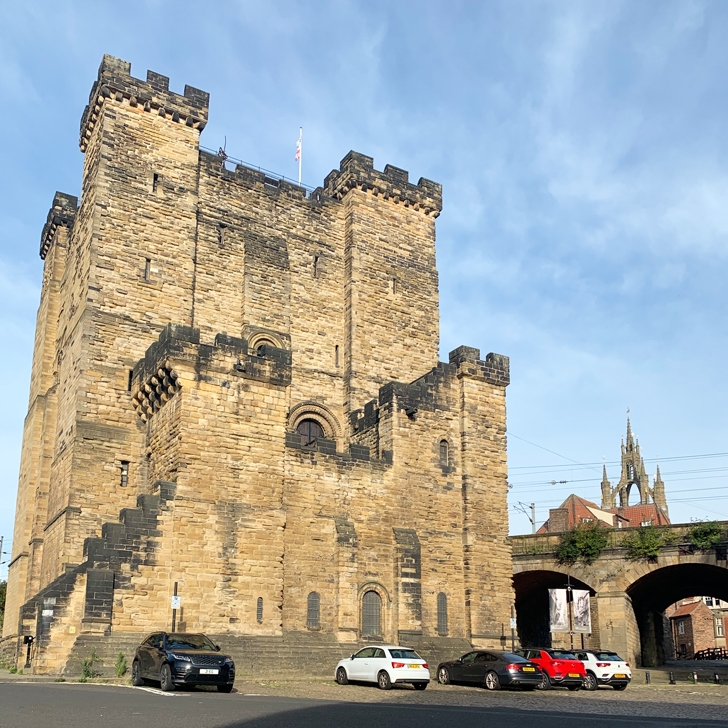
We headed towards Newcastle city centre. Past the castle (we decided to not go in) and to Gray’s Memorial. I’ll be honest with you, since we hadn’t really planned any Newcastle walking tour or similar (although I did look at some guided walks beforehand, but in the end, we decided against it), we spent the next hour or two browsing and shopping. Whilst also looking around and appreciating the buildings around us.
Newcastle does actually have a very picturesque old arcade, Grainger Market. Which features a selection of different market stalls, all covered. One particularly interesting store front was the one of ‘Marks & Spencer Original Penny Bazaar’. M&S has obviously long moved on to bigger premises and another vendor occupies this stall, but the sign is still up. From the original M&S stall back in 1895. I sure didn’t expect to see that.
After lunch, we decided to head to Wallsend. After all Newcastle is the Eastern end of Hadrian’s wall. So surely, we should go and check that out? Well, taking the Metro to Wallsend was easy. Finding the Segedunum Roman Fort wasn’t too hard either (although there wasn’t much to see walking past and the museum / café appeared shut), but we didn’t actually spot Hadrian’s wall itself. We walked the Hadrian’s Wall Path for a little while, until we got to the next Metro station and it was a pleasant walk, but it wasn’t quite what I expected. Oh well, you never know, until you try. But should you be heading to Newcastle any time soon, probably give Wallsend a miss and do your homework a bit better than me, if you’d actually like to see Hadrian’s wall (and yes, you obviously do want to see it when in the Tyne and Wear region).
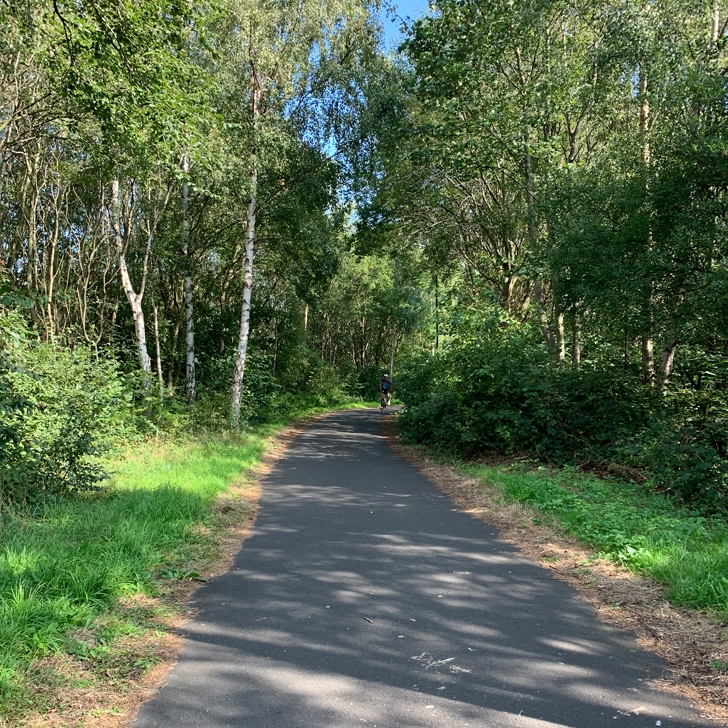
We did have a nice day in Newcastle, even though I somehow don’t seem to have much to report. I’m sure there’s loads more to see here, and you will now point out all the things we didn’t see. But that’s fine. We can always come back another time.
What to do in Tyne and Wear – Day Four
For Tuesday, we had pre-booked tickets for the Beamish Living Museum of the North (so you see, I really did come half prepared this time). And since we were originally thinking about cycling there, we went for 11 o’clock entry. Potentially giving us enough time to cycle there, without getting up at crazy hour… after all, we were on holiday.
But in the end, we went there by car rather than bike (Ok, I will admit, I was far too lazy for another long cycle ride, much to Mr T’s despair). Meaning, we had a little time to kill before (as we were up at the crack of dawn regardless… so much for having a lie in when on holiday).
To start the day, we headed to Penshaw Memorial, located just outside Sunderland and more or less on our way.

Penshaw Memorial is easy to spot, as you approach, since it is located on top of a hill. What looks like an ancient Greek temple is actually a replica built in the mid 19th century as a memorial for the 1st Earl of Durham (and no, don’t ask me why they went for a Greek temple lookalike at that time, I have no clue).
Checking it out on the internet beforehand, I ended up proper confused. On one hand it came up with the memorial being open 24/7, on the other hand the National Trust website claimed that the memorial was currently shut. Eventually we worked it out though. Yes, you can climb up the hill and visit the memorial (and enjoy the stunning views you get from there). But hidden in one of the 18 columns of the memorial is a spiral staircase, giving you access to an elevated walkway at the top. And whilst the National Trust usually offers guided tours up there, this bit was shut when we visited (and will remain shut for the foreseeable future).
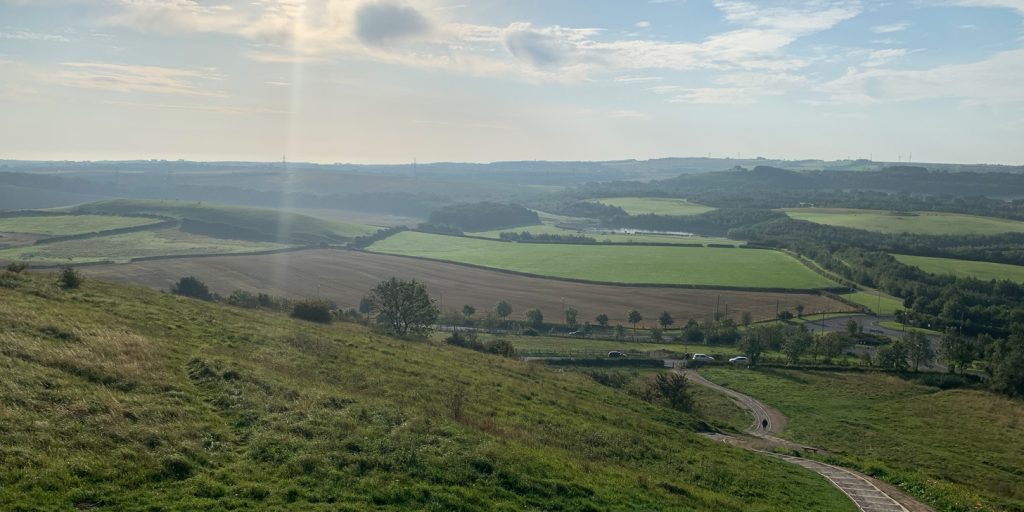
With the monument ticked of our list of things to do in Tyne and Wear, we were now on the hunt for a cup of coffee. Unfortunately, our Airbnb did have a kitchen, but no coffee making facilities… anyone that knows me, knows that a. I don’t function without coffee in the morning and b. I don’t do instant coffee. So, by that time, I was well desperate for my morning latte.
A quick glance at the map revealed Washington as the next bigger village / town, that was kind of on the way, so Washington was where we headed. Again, without any real plan of where we’d go. We just figured once we got to town, we would eventually find a coffee shop. It did take us a little while (our attempts to follow signs towards town centre left us stranded on a shopping centre car park), but eventually we made it to the older part of Washington. Driving past Washington Old Hall (the former home of the ancestors of George Washington, the first president of the United States), we parked up and found a gorgeous little café come antiques store come flower shop. Right up my street with mismatched furniture and crockery, home-baked cakes and cookies, loads of flowers and plants and odd bits of decorations, furniture and antiques. So, not only would I finally get my caffeine fix, I also ended up buying myself a vase (Mr T has long learned not to question whether we really need yet another vase, plant or bowl).
Caffeinated and ready to move on, we realised that it was still barely 10 o’clock. Enough time for yet another stop, before heading to Beamish Museum.
Since we left it off our itinerary the day before, we took a little detour and went to see the Angel of the North. Conveniently located right next to the motorway, it was convenient to get to. Not much walking required, so the entire stop-over took no more than 10 minutes.
The Angel of the North is a 20-metre tall angel statue, made of steel, with wings spanning over 50m. It is the largest statue in the UK and is said to be the largest angel statue in the world (but then again, I have no clue how many large-scale angel statues there are around the world… chances are, not that many). Sculpted by Antony Gormley, the Angel of the North was installed in 1998. And I guess it does qualify as one of the things you really need to see when in Sunderland and vicinity.
After all those detours, it was finally time for us to head to Beamish and go into the Living Museum of the North. But since there’s loads to see and talk about, I’ve written a whole separate post about the Beamish Museum and whether it is worth a visit. I’m already rather conscious that I might bore you to death… so if you are still with me, well done for being so persistent (or probably really desperate to see if after all my ramblings something remotely interesting might happen during our trip up north. Sorry to disappoint).
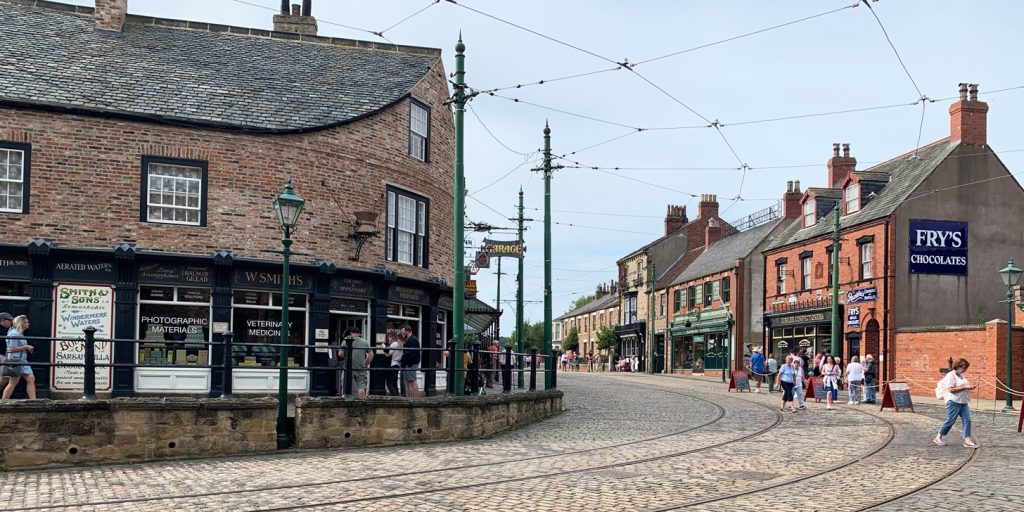
Let me just say so much. We’ve spent about four hours at the Beamish Museum, walking the length and width of their vast landscapes (and all in beautiful hot weather, who would have thought we’d have such great weather in September). But eventually, we were done with exploring and left Beamish.
Heading back to the Airbnb, we swapped the car for our bikes and headed back to Roker Beach one more time. This time actually armed with a blanket and towel. No, we are not lunatics. We didn’t intend to actually go swimming. Just dip our toes into the water (no way would I go any further, it was freezing cold) and lie in the sun on the beach for a little while.
Since it was our last evening, we headed into Sunderland for dinner. So far, we’ve always had dinner in the rental, so going out was nice. Quite a few of the restaurants we checked out online were still closed, so the choice was limited. The restaurant we eventually decided on looked great on the internet (and the food was rather delicious), But their take on current safety measures did not fill us with much confidence. They did not take down our details (nor provide any scan code or similar for us to check in). We were given paper menus, but I got the impression these same menus weren’t disposed of after use, but handed to every customer. I also doubted condiment bottles let alone tables and chairs were sanitised between customers. I won’t name and shame the restaurant here, but we did actually take the time afterwards to report them on the council website. Since it did not appear that they were adhering to any current safety measures at all.
Our trip up North – Day Five
Eventually our luck had to run out, as far as the lovely sunny and warm weather was concerned. Opening our eyes in the morning, the first noise we heard was the rain drops on the roof window. Not the best way to start your last day on holiday.
We had to vacate our rental by 10am, so after a quick breakfast, we started packing up the car. The original plan was to head towards Hadrian’s wall and do a little hike before heading back home. But with the rain (and the fact that we’ve walked and cycled loads in the last few days), we abandoned this idea and started our journey back south.
We did one last detour on the way home for some retail therapy at the Designer Outlet in York. It being a Wednesday and still fairly early in the day, we figured it wouldn’t be too crowded. And thanks to it all being under cover, the weather wasn’t an issue.


